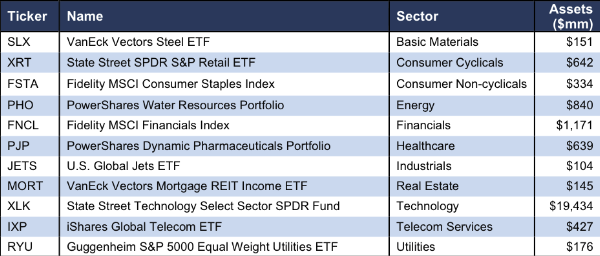How To Find The Best Sector ETFs 1Q18
 Finding the best ETFs is an increasingly difficult task in a world with so many to choose from. How can you pick with so many choices available?
Finding the best ETFs is an increasingly difficult task in a world with so many to choose from. How can you pick with so many choices available?
Don’t Trust ETF Labels
There are at least 42 different Technology ETFs and at least 209 ETFs across eleven sectors. Do investors need 19 choices on average per sector? How different can the ETFs be?
Those 42 Technology ETFs are very different. With anywhere from 20 to 369 holdings, many of these Technology ETFs have drastically different portfolios, creating drastically different investment implications.
The same is true for the ETFs in any other sector, as each offers a very different mix of good and bad stocks. Consumer Non-cyclicals rank first for stock selection. Energy ranks last. Details on the Best & Worst ETFs in each sector are here.
How to Avoid Paralysis By Analysis
We think the large number of Technology (or any other) sector ETFs hurts investors more than it helps because too many options can be paralyzing. It is simply not possible for the majority of investors to properly assess the quality of so many ETFs. Analyzing ETFs, done with the proper diligence, is far more difficult than analyzing stocks because it means analyzing all the stocks within each ETF. As stated above, there can be as many as 369 stocks or more for one ETF.
Anyone focused on fulfilling the fiduciary duty of care recognizes that analyzing the holdings[1] of an ETF is critical to finding the best ETF. Figure 1 shows our top-rated ETF for each sector.
Figure 1: The Best ETF in Each Sector

Sources: New Constructs, LLC and company filings
Amongst the ETFs in Figure 1, VanEck Vectors Mortgage REIT Income ETF (MORT) ranks first overall, U.S. Global Jets ETF (JETS) ranks second, and iShares Global Telecom ETF (IXP) ranks third. VanEck Vectors Steel ETF (SLX) ranks last.
How to Avoid “The Danger Within”
Why do you need to know the holdings of ETFs before you buy?
You need to be sure you do not buy an ETF that might blow up. Buying an ETF without analyzing its holdings is like buying a stock without analyzing its business and finances. No matter how cheap, if it holds bad stocks, the ETF’s performance will be bad. Don’t just take my word for it, see what Barron’s says on this matter.
PERFORMANCE OF FUND’S HOLDINGS = PERFORMANCE OF FUND
Analyzing each holding within funds is no small task. Our Robo-Analyst technology enables us to perform this diligence with scale and provide the research needed to fulfill the fiduciary duty of care.[1] More of the biggest names in the financial industry are now embracing technology to leverage machines in the investment research process. Technology may be the only solution to the dual mandate for research: cut costs and fulfill the fiduciary duty of care. Investors, clients, advisors and analysts deserve the latest in technology to get the diligence required to make prudent investment decisions.
If Only Investors Could Find Funds Rated by Their Holdings
Our ETF ratings leverage our stock coverage. We rate ETFs based on the aggregated ratings of the stocks each ETF holds.
VanEck Vectors Mortgage REIT Income ETF (MORT) is not only the top-rated Real Estate ETF, but is also the overall top-ranked sector ETF out of the 209 sector ETFs that we cover.
The worst ETF in Figure 1 is VanEck Vectors Steel ETF (SLX), which gets a Neutral rating. One would think ETF providers could do better for this sector.
This article originally published on January 25, 2018.
Disclosure: David Trainer, Kyle Guske II, and Pete Apockotos receive no compensation to write about any specific stock, sector, or theme.
Note: This article was contributed to ValueWalk.com by Kyle Guske II, New Constructs
Category: Sector ETFs




